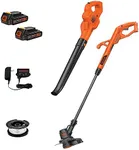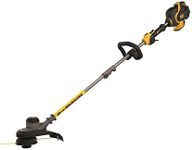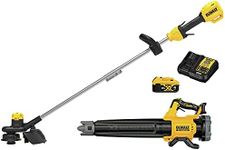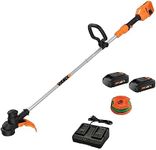Buying Guide for the Best Battery Powered Weed Eater
Choosing a battery-powered weed eater can make yard work much easier and more convenient, especially if you want to avoid the hassle of gas engines or tangled cords. The right model for you will depend on the size of your yard, the type of weeds or grass you need to trim, and how comfortable you want the tool to be during use. Understanding the key features will help you find a weed eater that matches your needs and makes your gardening tasks more enjoyable.Battery VoltageBattery voltage tells you how powerful the weed eater is. Higher voltage usually means more cutting power, which is helpful for thicker weeds or larger areas. Weed eaters typically range from about 18V to 80V. Lower voltage models (18V-24V) are lighter and good for small yards with light grass, while mid-range (36V-40V) can handle moderate weeds and medium-sized yards. High voltage (60V-80V) is best for tough weeds or larger properties. Think about the type of vegetation you have and the size of your yard to decide which voltage range fits your needs.
Battery Capacity (Ah)Battery capacity, measured in amp-hours (Ah), tells you how long the weed eater can run before needing a recharge. A higher Ah rating means longer run time. For small yards or quick jobs, a lower capacity (2.0Ah-2.5Ah) may be enough. For bigger yards or longer sessions, look for higher capacity batteries (4.0Ah or more). If you don’t want to stop and recharge often, choose a model with a higher Ah or consider buying a spare battery.
Cutting WidthCutting width is the diameter of the area the weed eater can trim in one pass. A wider cutting width (14-16 inches) lets you cover more ground quickly, which is great for large or open spaces. Narrower widths (10-12 inches) are easier to control and better for tight spots or detailed work. If you have a lot of open lawn, go for a wider width; if you need to trim around flower beds or fences, a narrower width may be more practical.
WeightThe weight of the weed eater affects how easy it is to handle, especially during longer sessions. Lighter models are easier to maneuver and less tiring, making them ideal for smaller people or those who want a more comfortable experience. Heavier models may offer more power but can be harder to use for extended periods. Consider your own strength and how long you’ll typically use the tool when deciding on the right weight.
Line Feed SystemThe line feed system controls how the cutting string is released. There are manual, bump feed, and automatic feed systems. Manual systems require you to stop and adjust the line, bump feed lets you tap the head on the ground to release more line, and automatic feed does it for you as needed. If you want the easiest experience, look for automatic feed. If you don’t mind a little extra work and want more control, bump or manual feed may be fine.
Adjustable Shaft and HandleAn adjustable shaft or handle lets you change the length or angle of the weed eater to fit your height and reach. This makes the tool more comfortable and helps prevent back strain. If multiple people will use the weed eater or if you want to avoid discomfort, look for models with adjustable features.















